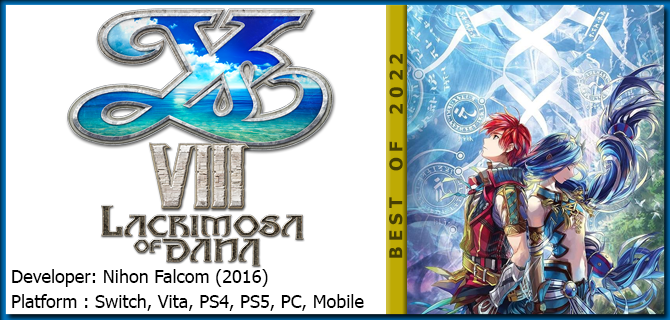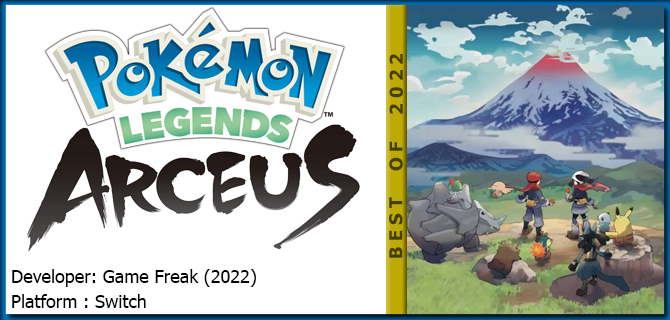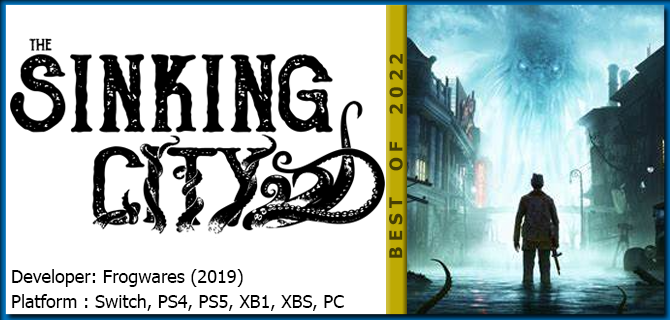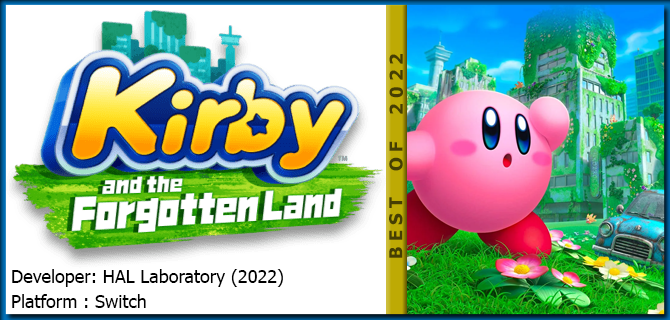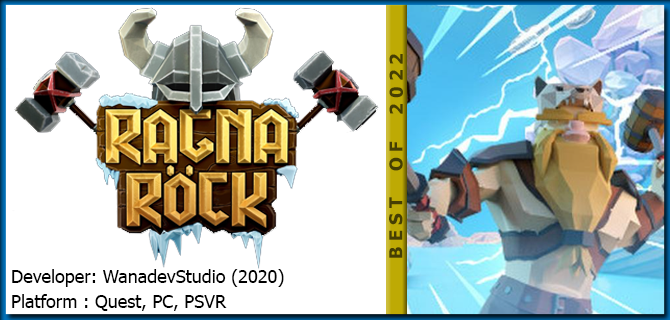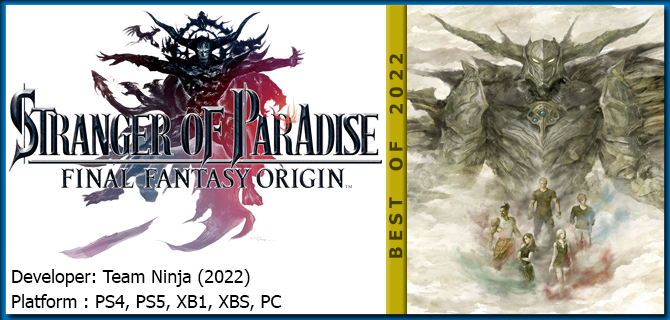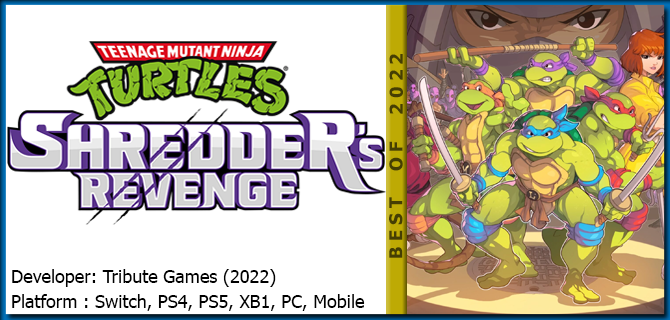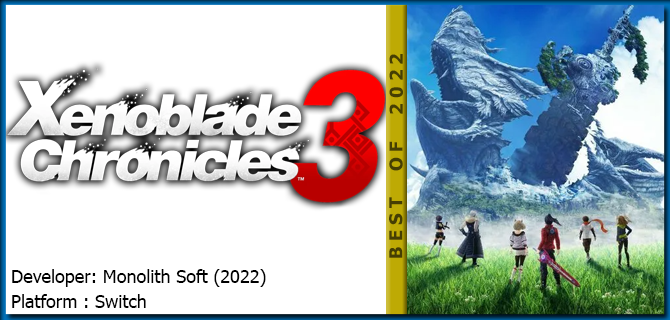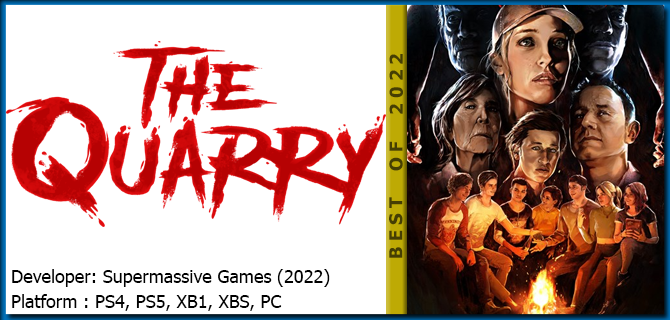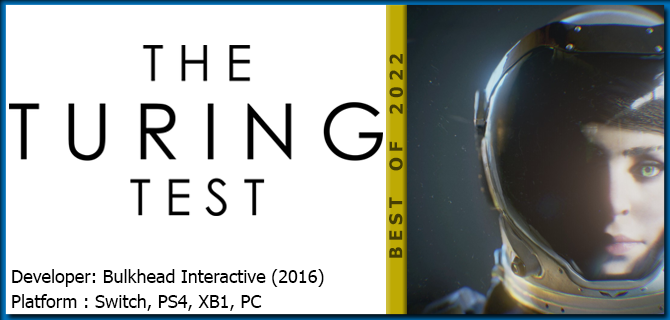Well, another year is behind us, and as usual, I frittered away a huge chunk of it playing video games. To help justify spending all that time on viddygames, here’s a big, long list of the ones that I liked most.
If this is your first time reading one of my Top X Games lists, I don’t make them based on games released in the previous year, but rather, games I played in the previous year. There is one constant rule: I must have played the game for the first time in the last year. And I added a new criteria for 2022, which is: no two games from the same franchise. Helps to keep the list a little more diversified. Oh, and the games are listed in the order that I played them. No playing favourites among the favourites.
Okay, that’s the preamble. Let’s go!
In 2021, I played most of the games in the Ys series, and most of them were really good. Ys: Memories of Celceta even managed to secure a spot on my Top 10 list for 2021. So the only video game “goal” I had going into 2022 was to finish off the Ys series by playing through the two games I had outstanding: Ys VIII: Lacrimosa of Dana, and Ys IX: Monstrum Nox. Needless to say, they were also really good.
Lacrimosa of Dana in particular gets to adorn this list because it is definitely my favourite game in the series. It takes everything that was great about Memories of Celceta and makes them even better. So really, you could probably just read what I wrote last year and it would mostly still apply, and I could skip writing another paragraph here. But I suppose that I should at least go over some of the highlights. Specifically, I enjoy how the combat is exciting and very speedy, exploring is more fun than ever with map and treasure box completion percentages for every area, the metroidvania-style way that the world slowly opens up as you gain new traversal abilities is always appreciated, and I think that this game has the best cast of party members in the series.
One thing that I cannot praise enough about Ys VIII is that it has one of my absolute favourite video game soundtracks of all time. All Ys games have phenomenal music, but Ys VIII’s in particular really stands out to me. Not only did I get an imported physical copy of the soundtrack, but I also bought the Ys VIII: Super Ultimate arrange album, and I listen to both of them quite often. Sunshine Coastline specifically is straight up one of the best video game songs I’ve ever heard, and multiple official and cover versions of it live on my phone so I can listen to them all the time.
I mean, it’s Pokémon, right? Everyone has at least a vague idea of what Pokémon is, and it never changes, so I don’t really need to write a whole thing about why this particular entry is so worthy of my praise. Or do I?
Yeah, see, the thing about Pokémon Legends: Arceus is that it’s not like every other Pokémon game that came before it. This spin-off was actually a large-scale test of how an open-world Pokémon would work, a concept that began with the Sword & Shield DLC, and was fully-realized in Scarlet & Violet later in 2022. However! Legends is special because while it did introduce plenty of new and refined mechanics that carried over into S/V, there are just as many elements that didn’t get carried forward and distinguish it from the rest of the series. For instance: the focus on catching Pokémon using stealth instead of having to battle and weaken them first. You also need to fill in a number of criteria to complete a Pokémon’s entry in the Pokédex, as the whole point of the story is to learn about Pokémon instead of just catching them to complete the checklist. It’s really just adding sub-checklists to the main checklist, but I appreciated the concept and the execution made filling in each entry all that more fulfilling. Pokémon Legends: Arceus also has a massive list of quality-of-life features that remove all kinds of tedium that has persisted in the series up until now. Being able to evolve a Pokémon that meets its evolution criteria from the menu whenever you so choose, for example. It’s a feature I missed sorely while playing Scarlet later in the year.
I guess the other really stand-out thing about Pokémon Legends: Arceus is that it’s got a much more interesting story than pretty much any previous game. All the usual Pokémon story tropes are thrown out the window here: there are no gyms, no evil team, and no Elite Four. Oh and also it takes place in the distant past when people were still afraid of Pokémon, so it’s kind of ends up being your job to broker peace between humans and Pokémon. It’s not an especially deep story, but the fact that it’s so different from the usual fare, as well as the wealth of fun characters that you meet along the way, really kept it interesting. I was certainly always excited to see what was going to happen next, and that’s not something I think I’ve ever said about the story in a Pokémon game before.
As usual, most of the games on this list are sequels, or at least part of a long-standing video game series. The Sinking City… sort of fits that description? Frogwares’ bread-and-butter are Sherlock Holmes adventure games, and while I’ve never played any of those, from what I’ve heard, The Sinking City shares a whole lot of DNA with them. The major difference, of course, being that The Sinking City of based on a whole other series of literature: the works of H.P. Lovecraft.
An adventure game first and foremost, The Sinking City places you in the shoes of private detective Charles Reed, as he investigates the island city of Oakmont, MA, looking for clues about the nightmares he’s been having recently. Oakmont is a respectably large open world to explore, though it’s seen better days and about half of it is severely flooded. Most of the gameplay has you running (and driving boats) around town, talking to citizens, collecting clues, and solving the city’s myriad mysteries. A lot of the story comes from dialogue trees, and the rest from sequences where you have to piece together what happened in crime scenes by locating clues and connecting them in the right order. It’s never particularly challenging, but it’s fun. There are also a handful of key decisions that alter how the story plays out, which makes this game worth replaying at least once to see all the alternate scenes.
As an indie game with the trappings of a AAA title, there is of course a splash of combat thrown in to get your blood pumping. Though it’s generally inoffensive, combat was never really overly engaging and I felt like it was mostly just in the way of me getting to the next story sequence or location to investigate. There are a sum total of four unique monsters to fight (with a couple variants) along with humans, which did make the combat encounters feel a little repetitive. On the other hand, Charlie collects an expansive armory over the course of the game, and there are, of course, the requisite skill trees that allow you to customize his abilities to your liking. While I think I could have enjoyed The Sinking City just as much if combat had been removed entirely, you do get to slaughter a whole chapter of KKK members at one point, and that was actually pretty satisfying.
Much like Pokémon, it’s pretty easy to look at the core Kirby series and point out how they tend to change very little between each installment. And while that does mostly hold true for Kirby and the Forgotten Land, I just had so much fun playing it that I couldn’t in good conscience leave it off of this list.
The main thing that makes this Kirby game different from any other Kirby game is that it takes place in actual 3D space. Yes, the levels are still linear and you typically don’t have a ton of ground to explore, but the simple change in perspective is more than enough to make Forgotten Land stand out from those that came before it. And there are a few levels that take place in comparatively large open areas, so that additional dimension is more than justified. The other major change here is that for the first time ever, there is an actual upgrade system for Kirby’s powers, which was a pretty compelling addition in my opinion. Some powers gain new abilities as you upgrade them and some get a buff to power and/or range, but if I’m being honest, I was just eager to see the new hat design for each upgrade more than anything. Also the fully powered-up Sword ability is super broken and I was a big fan of that.
Ever since Triple Deluxe, every main-series Kirby game has had some sort of gimmick that factors fairly heavily into the gameplay (Hypernova, Robobot mechs, and Friend Actions). Forgotten Land’s is Mouthful Mode, wherein Kirby inhales an oversized object and sort of molds his body around it, thus gaining the abilities of said object to help clear obstacles or solve puzzles. It’s a little disturbing to see at first, but there are plenty of different objects to suck up, and the sheer variety meant it was always fun and I was always excited to see what would come next. There are also a ton of short challenge stages based around each ability and Mouthful object, and completing them under a set time will earn you prizes. These are completely optional, and I found them to be a lot of fun and a nice way to break things up between the longer main levels.
When I bought a Meta (née Oculus) Quest 2 in late 2020, it was a bit of an impulse purchase. A crazy-expensive impulse purchase. Based on what I had seen of VR games up to that point, I wasn’t expecting anything world-changing, just a unique kind of fun. But there has been one VR game included on my Top 10 list for the last three years, and I feel like that says a lot.
While the last two years featured horror games, 2022’s big VR win was… a rhythm game, of all things? Yup, RagnaRock is a rhythm game alright, and a fairly simple one at that. This is a drumming game, and you only have four drums to worry about, with absolutely no kick pedal in there to screw everything up. There’s no worrying about matching colours or directions like in BeatSaber, you’re just swinging your arms about like a crazy person to mash those drums as the notes fly over them. Oh and also it’s got a sweet Viking theme, which really goes a long way to both earn and retain my interest.
Of course, as fun as the mechanics of any rhythm game might be, that’s only half the battle. The other half? The soundtrack, of course. RagnaRock, in some delightful twist of fate, has a soundtrack that is geared directly toward my very specific tastes. While there are a couple outliers here and there, the two subgenres with the most representation are folk metal and celtic punk. As a cherry on top, the first DLC pack was all Gloryhammer, and, well, I’m a pretty big Gloryhammer fan. The other massively important feature that RagnaRock has is the ease of adding custom songs. You just download a program, plug your headset into your computer, pick the songs you want and hit the sync button. It’s that easy! And yes, while the custom song selection is bit paltry compared to that of the massively-popular BeatSaber, there’s still a ton of music to choose from. It certainly didn’t take me very long to double the game’s song selection, and I’m still going back to add more every once in a while.
Something that a lot of people probably don’t know about me is that Final Fantasy (specifically the Dawn of Souls remake) is my third-favourite game in the series, right there under FFVIII and FFXIII. Yeah, I know, I’ve got pretty weird taste. But that’s important here because it means I was totally jazzed when Square-Enix revealed that they were making a high-budget 3D action remake/prequel/re-imagining/???? of the original Final Fantasy.
Now let’s get things straight: Stranger of Paradise: Final Fantasy Origin is not the kind of game I would normally purchase. It’s an ultra-tough character action game that relies heavily on being able to read enemy movements and react to them with split-second reflexes. I do not have that ability. So playing though this game was unfortunately frustrating for me a lot of the time. Despite that, every other facet of it was so enjoyable to me that I felt I absolutely needed to place it on this list. The fact that it is actually a prequel to the original FF goes a long way, and I was not disappointed by the completely bonkers plot. The characters and script are 90% cheese by volume, and in the absolute best way possible. The job system is very robust and gives you a ton of options and freedom in how you play the game. And oh me gosh I would be remiss to no mention how hilariously stupid the characters end up looking when you choose the auto-equip option to dress them in the best available gear. It’s an absolute riot! And even though it could be frustrating a times, I feel like I should clarify that I did still find the gameplay to be a lot of fun, it was just a lot harder than I’d normally like.
What really sold me on Stranger of Paradise, however, was something I knew nothing about going in: the heaping gobs of fanservice. There are 15 full levels (and a few smaller ones) in this game, and each one of them is heavily inspired by a location from one of the 15 numbered Final Fantasy games. Early on in the game, you travel through a lush jungle-esque area that has a weather-changing mechanic, which at first I though was oddly reminiscent of Sunleth Waterscape from FFXIII. Then I realized that the music I was hearing was a heavily arranged, more solemn version of that stage’s theme, and I finally realized what was going on. From then on, I was more excited than ever to progress past each stage to see which FF game the next stage would be from, and which area it would be based on. The fact that Stranger of Paradise ended up being a love letter not only to FF1, but the Final Fantasy series as a whole, made it all that much more special to me.
Okay, like, do I even need to explain this one? I’m a big ol’ TMNT fanboy, there’s no hiding that. I wear that part of me on my sleeve. So yeah, a new TMNT brawler that’s heavily inspired by the 90’s arcade games, but with a number of modern touches? That’s absolutely going to be in my top ten.
Where do I even start here? The graphics are amazing! Tribute Games captured the 80’s TMNT cartoon look so well, but added just enough of their own style to make it stand out on its own. The animations are at a Paul Robertson-level of quality, likely because Paul Robertson actually worked on this game. The levels are varied and well-designed, and the story is told through short animations that happen within the stages, and a single image at the end of each. Controls are tight, and the characters have a wider array of moves than ever before.
But really -and I’m starting to feel like a broken record at this point- the thing that put Shredder’s Revenge over the top is the soundtrack. I didn’t really pay enough attention to the trailer music pre-release, so I was a little worried that the soundtrack might not hit the highs that the classics did, but there no question that it surpasses those classic Konami soundtracks. Composed by Tee Lopes, the genius behind the Sonic Mania soundtrack, the OST to Shredder’s Revenge is absolutely perfect in all ways. I listen to it all the time, whether I’m working, running, driving, drawing, etc, etc. I honestly think it should be an actual crime that it wasn’t even nominated for best soundtrack at the 2022 Game Awards. Did Elden Ring even have music? I played that game for well over 100 hours and I couldn’t hum you a single bar from it. #ArrestGeoffKeighley
At this point, I think that I have to admit it: I have an obsession with the Xenoblade Chronicles series. Each game in the series has completely enraptured me, and there’s a very good chance that on any given day, at any point in time, I’m thinking about something related to Xenoblade. XC3 is obviously no exception to this rule, and if I had to pick one of the games on this list as the Number One? This would be it, no question.
Xenoblade Chronicles 3 picks up somewhere after the events of both previous games, though we don’t learn exactly when (or how!) until the final hours of the story, and I’d rather not get too into it, because I don’t want to spoil any of the plot. However, it is important to note that one of XC3’s major themes is the combination of elements of its two predecessors. This is prevalent in everything from the characters to the world design to the music to the battle system. Aionios is home to two rival factions, Keves and Agnus, and it doesn’t take long to see that each side takes inspiration from XC1 and XC2 respectively. Despite all this, though, XC3 actually has a lot less fanservice than I was initially expecting and is quite handily able to stand on its own. I was actually a little disappointed by that for a while, but quickly grew to appreciate the game for how unique it ended up being.
I could go on an on about this for some time, but here’s the short version: Xenoblade 3’s soundtrack is good. It’s really, really good. It’s not nearly as bombastic as the OSTs of the previous games, but the more sombre tracks fit in perfectly with the particularly dire themes of the story. And of course, it’s still a genuine treat to listen to! I absolutely cannot wait for a physical release so that I can complete my collection!
Alright, so indie horror games are kind of my thing. When I’m not playing games, there’s a very good chance that I’m watching someone else play an indie horror game. And this is mostly because the AAA horror market is… pretty small. So when a AAA horror game does come around, and it’s as good as The Quarry, well, that’s a pretty special occasion.
A spiritual sequel to one of my favourite horror games of all time, Until Dawn, The Quarry is another tribute/send-up of horror tropes. This one lands squarely in the classic “summer camp” setting, and puts the fate of over a dozen people in your hands. The seven main characters are teenage camp counselors who get stranded at the camp on the day that they were scheduled to leave. While they’re told to stay put and not cause trouble until the camp owner can return with help, they are teenagers, and proceed to start getting into all sorts of trouble with the local wildlife and some nice country bumpkins who live nearby. It’s a fun tale with plenty of twists and turns, and of course, crams in just about as many clichés as possible. Sadly, I did have the “twist” spoiled for me a while before I actually played the game myself, but it was still a great ride. Honestly, the dialogue alone is enough reason the play through this game.
This is also basically just an interactive movie where you get to make a few choices and press a few buttons once in a while to alter how the story unfolds. Sometimes you also get to drive a character around for a bit, but it’s largely just to move them from scene A to scene B, and maybe find a trinket along the way. I honestly don’t mind the lack of gameplay, because seeing the results of my choices (which were unexpectedly surprising a lot of the time) was fun enough to keep me engaged. One really nice extra feature is that The Quarry includes a “movie mode” that effectively just plays itself, letting you tamper with the characters’ personalities to alter how things play out. It’s a really nice alternate way for people to experience all the game has to offer, without having to put up with all of those pesky QTEs.
While indie horror is absolutely my go-to genre when I just need to chill or whatever, I’ve recently re-discovered how satisfying first-person puzzlers can be. Portal set the benchmark forever ago, and it seems like each year lately I’ve been finding one really good first-person puzzle game that I like almost as much – The Talos Principle in 2020, The Outer Wilds in 2021, and now The Turing Test.
As with most of the indie games I play these days, I first learned about The Turing Test via a YouTube let’s play video. It wasn’t 30 minutes into the video that I stopped it and decided that this was a game that I would absolutely need to play myself. The idea of having to move around power blocks to activate doors and lifts and magnets and such, all in an effort to move to the next puzzle chamber, is exactly the kind of gameplay that I’m looking for, so I went ahead and purchased the game. The lightly philosophical plot of the game excited me greatly, after having been so captivated by The Talos Principle’s deep dive into philosophy. The setting of a space station where the crew have gone missing and your only companion is an AI voice that may or may not be evil? Right up my alley. It’s still hard to believe that I slept on it for an entire year after buying it!
While The Turing Test is a somewhat basic take on the “solve puzzles to get to the next puzzle room” when compared to its peers, that doesn’t make it any less satisfying to play. Quite the opposite actually, as the fact that I was able to clear the entire game without ever getting stuck on a puzzle made me feel very smart. The way that most of the story is told though dialogue between your character and the aforementioned AI is a fun and unique way to do it, and the requisite notes and audio logs that add more backstory are present if you really want to get into the lore. Every chapter also has an optional puzzle room, which all have slightly harder puzzles than the main rooms, and they are definitely worth tackling for not only the satisfaction, but the interesting rewards. At the end of the day, The Turing Test is a very solid, enjoyable experience all around.

